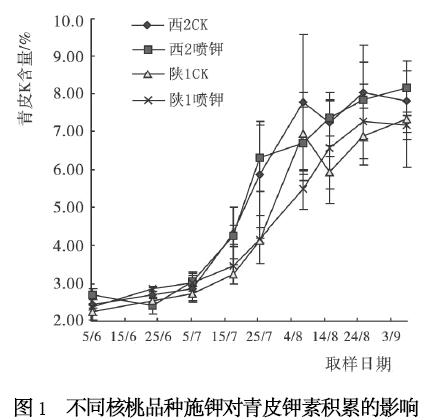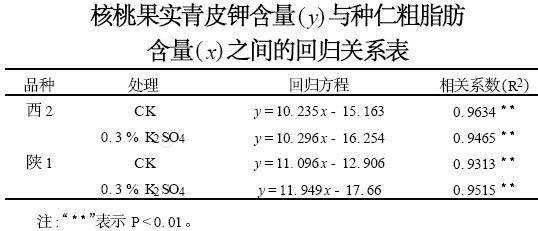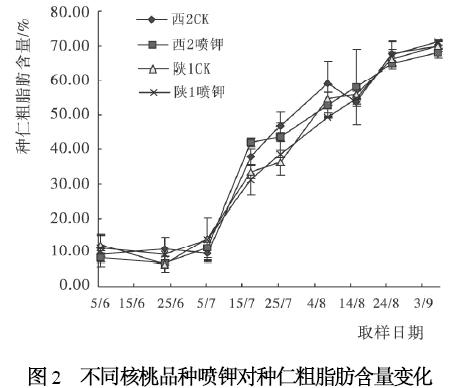Walnut has always been an important economic tree species in Mentougou District. At present, walnut production has become the most characteristic pillar industry in the forest industry of Mentougou District. Walnut kernel oil content is generally about 60%, high up to 75% to 80%, ranking first in woody oil, known as the "oil depot." Walnut fat content is not only an important quality indicator, but also a major technical and economic indicator. The selection of high-oil walnut varieties based on crude fat content as an indicator and the study of high oil production and cultivation techniques are the basis for promoting the production, processing, and upgrading of walnuts. Potassium is a recognized quality element. Most fruit trees absorb more potassium than nitrogen and phosphorus. Researches on the effects of potassium nutrition on the yield and quality of fruit trees have focused on citrus fruits, grapes, bananas, apples, and other fresh fruit, and there have been few studies on dried fruits. In the United States from the 1920s to the 1980s, many scientists studied the effect of potassium on the growth and yield of pecans in the Americas. At that time, due to the difficulties in the study of potassium nutrition, the effect of potassium was not easily understood. However, potassium is indeed important for walnut growth. Pe'er et al. found that the fat in the kernels was positively correlated with the potassium in the peels during the development of American pecan fruits. Teng Kangli and Zhang Zhihua and others found the same phenomenon in Yuanfeng walnuts. Hunter studied the effect of spraying potassium nitrate on the nucleolus content and oil content of Moore kernels and found that potassium application can increase nucleolus yield and oil content. The effects of spraying potassium sulfate on the fruit weight of single fruit weight and the crude fat content of potassium and kernels in walnut peels were studied in experiments to provide scientific basis for the cultivation and management of walnuts and high oil production. .
1 Materials and Methods
1. 1 test material
The experiment was conducted in the Tianzhuang walnut demonstration park in Yanchi Town, Mentougou District, Beijing. The test soil was carbonated cinnamon soil, and its basic physical and chemical properties were: organic matter content 21.73 g · kg-1, alkaline hydrolysis N content 79. 09 mg · kg-1, nitrate-N content 16. 06 mg · kg- 1, ammonia N content 19.16 mg · kg-1, available P content 19.21mg · kg-1, available K content 455.97mg · kg-1, soil pH value of 8.23. The test tree was a walnut plant variety O Xilin No.2 that was planted in the garden in 1997. (In 2004, the self-rated kernel was used to measure fat content. The crude fat content can be measured by the crude fat analyzer. It has a variety of models, the most common being SZF-06B Crude Fat Analyzer, SZF-06A Crude Fat Analyzer) was 72.72%, represented by high oil varieties, referred to as Xi 2) and Shannu 1 (2004). 60. 94%, representative of low oil varieties, later referred to as Shaan 1).
1. 2 test methods
A randomized block design was used in the trial. Each species was set with a clear water control and 0.3% potassium sulfate treatment (3 times foliar application on May 16, June 23, and July 17 respectively). 3 replicates, 6 strains per species, 12 in total. On May 16, 2006 and June 23, 2006, 500 g/strain of diammonium phosphate was applied twice in the form of point fertilizer, and water was applied immediately after fertilization. From June 5th onwards, samples were taken every 10 days. Each time, six fruit were uniformly collected from each point of the main distribution area of ​​the fruit of each test tree, washed, and the peels and kernels were peeled off and then dried at 70 °C. Dry for 48 h, grind over 40 mesh sieves separately for preparation. Samples were processed with the extraction and related measurements were taken. The crude fat content was determined by Soxhlet extraction and potassium by flame. Data processing was analyzed using the software SPSS 13. 0 (SPSS Inc. , USA) and Excel.
2 Results and Analysis
2.1 The effect of potassium sulfate spraying on the accumulation of potassium in walnut peels is shown in Fig. 1. Spraying with potassium sulfate did not significantly affect the potassium content of the walnuts of the two walnut varieties. During the entire fruit growth period, the curve of potassium content of the treated fruits was similar. From June 5th to July 5th, walnut fruits developed into the fruit's rapid growth stage and hard nucleus stage. The potassium content of the peel remained basically stable; afterwards, on August 7th, the walnut fruit developed into the oil-conversion period, and the potassium of the peel was exponential. Accumulation, then the trend of potassium accumulation slowed. An analysis of variance of the potassium content of walnut peels at each sampling period showed that the potassium content of the two varieties of walnuts differed significantly between the two varieties of walnuts on July 17th, July 25th, and August 15th, and potassium spraying was There was no significant difference between the controls; there was no significant difference between the treatments at the other sampling periods.

Effect of potassium sulfate spray on the changes of crude fat content during development of different walnut varieties
The accumulation of crude fat in walnut kernels was not affected by the variety and potassium spray. The crude fat content of the kernels remained stable until July 5, and the crude fat content of the kernels accumulated exponentially after entering the oil-conversion stage, as shown in Figure 2. After analysis of variance of crude fat content of kernels at different sampling periods, the results showed that: on July 17 and July 25, samples of walnuts, Xi 2 and Shan 1, and 2 varieties of kernels had significant differences in crude fat content. The effect of potassium was not significant; on the contrary, the sampled walnut on August 7 was significantly lower than that of the control, but the effect of the variety was not significant.
2.3 Correlation Analysis of K Content in Walnut Peel and Crude Fat Content in Seeds
During the whole fruit growth period, the curve of the potassium content of the peel of the fruits and the change curve of the crude fat content of the seeds maintained a similar trend (Figs. 1 and 2). From the table, the potassium content of the walnut of the walnut fruit treated by the 4 treatment was significantly positively correlated with the crude fat content of the seed kernel (4 treatments P<0.01), and the linear relationship between the potassium content of the walnut peel and the crude fat content of the kernels. The slopes of the relationship were 10.235 (West 2, CK), 10.296 (West 2, potassium spray), 11.096 (Shaan 1, CK), and 11.949 (Shaan 1, potassium spray), respectively. The slope was greater than that of the control. The slope of Shaan 1 was greater than that of Xi 2, indicating that the accumulation of potassium in the former was more effective than the latter in the accumulation of crude fat. The correlation coefficients of the treatments reached 0. 9634 (West 2, CK), 0. 9465 (West 2, potassium spray), 0.913 (Shaan 1, CK), 0. 9515 (Shaan 1, potassium spray).

3 Discussion
In the study of cultivation of high oil crops, there is no shortage of research reports on the application of potassium to increase the fat content of kernels. The study also found that there was a very significant positive correlation between the potassium content in the walnut peel and the crude fat content of the seed kernel, which is basically the same as previous studies. Therefore, this can be considered as a nutritive characteristic of walnut fruit development. The study found that the potassium spray treatment had no significant effect on the K content and the crude fat content of the walnut kernels. This may be related to the high soil available K content (455.97 mg/kg, more than one-time excess of 170 mg/kg of soil available potassium supply index). It can be seen that the effect of potassium application is not obvious on the potassium-rich soil, and the excessive fat content of the kernels is also reduced due to excessive potassium. However, spraying K2 SO4 treatment still resulted in a slight increase in the weight and yield of the two walnut varieties compared to the control. Therefore, the main contribution of potash fertilizer is to increase production, and thus also increase oil production per hectare. During the oil conversion period of walnut fruit development, the sampling and measurement results showed that the K content and the crude fat content of kernels in walnut variety Xi 2 were significantly higher than those in Shan 1 . Leaf analysis results showed that the K contents in the leaves were 1.43 % (West 2CK), 1.39 % (West 2 spray K), 0.84 % (Shaan 1CK), and 0.91 % (Shaan 1 spray K), respectively. The potassium content in the West 2 leaves was significantly higher than that in Shaan 1, although the K in the leaves was higher than the lower limit of the leaf fertilization potassium nutrient reference standard (0.75% to 1.25 %), field observations revealed that the walnut fruit development In the late period, there were still some K-deficient symptoms in the leaves of Shaanxi 1 . Hunter et al. found that the high content of potassium in the leaves of American pecan nuts has a high content of fat in the nuts, and vice versa. Therefore, under the same conditions, the walnut variety Xi 2 can obtain higher oil content than Shaan 1, and it is also more suitable for promotion as a high-oil walnut processing variety.
bends
Size
Seamless(SMLS) Elbows : 1/2"-24" ,DN15-DN600
Butt Welded Elbows (seam) :24"-72",DN600-DN1800
Type
LR 30,45,60,90,180 degree SR 30,45,60,90,180 degree
1.0D, 1.5D, 2.0D, 2.5D, 3D,4D,5D,6D,7D-40D.
Thickness
SCH10,SCH20,SCH30,STD SCH40, SCH60, XS, SCH80., SCH100, SCH120, SCH140, SCH160, XXS
Standard
ASME,ANSI B16.9;
DIN2605,2615,2616,2617,
JIS B2311 ,2312,2313;
EN 10253-1 ,EN 10253-2
Material
ASTM
Carbon steel(ASTM A234WPB,,A234WPC,A420WPL6.
Stainless steel(ASTM A403 WP304,304L,316,316L,321. 1Cr18Ni9Ti, 00Cr19Ni10,00Cr17Ni14Mo2, ect.)
Alloy Steel:A234WP12,A234WP11,A234WP22,A234WP5,
A420WPL6,A420WPL3
DIN
Carbon steel:St37.0,St35.8,St45.8
Stainless steel:1.4301,1.4306,1.4401,1.4571
Alloy steel:1.7335,1.7380,1.0488(1.0566)
JIS
Carbon steel:PG370,PT410
Stainless steel:SUS304,SUS304L,SUS316,SUS316L,SUS321
Alloy steel:PA22,PA23,PA24,PA25,PL380
GB
10#,20#,20G,23g,20R,Q235,16Mn, 16MnR,1Cr5Mo,
12CrMo, 12CrMoG, 12Cr1Mo
Pipe Bends
Stainless Steel Bends, Carbon Steel Bends, Steel Tube Bender, 180D Return Bends
Cangzhou Weiheng Pipe Industry Co.,Ltd , https://www.czweiheng.com


